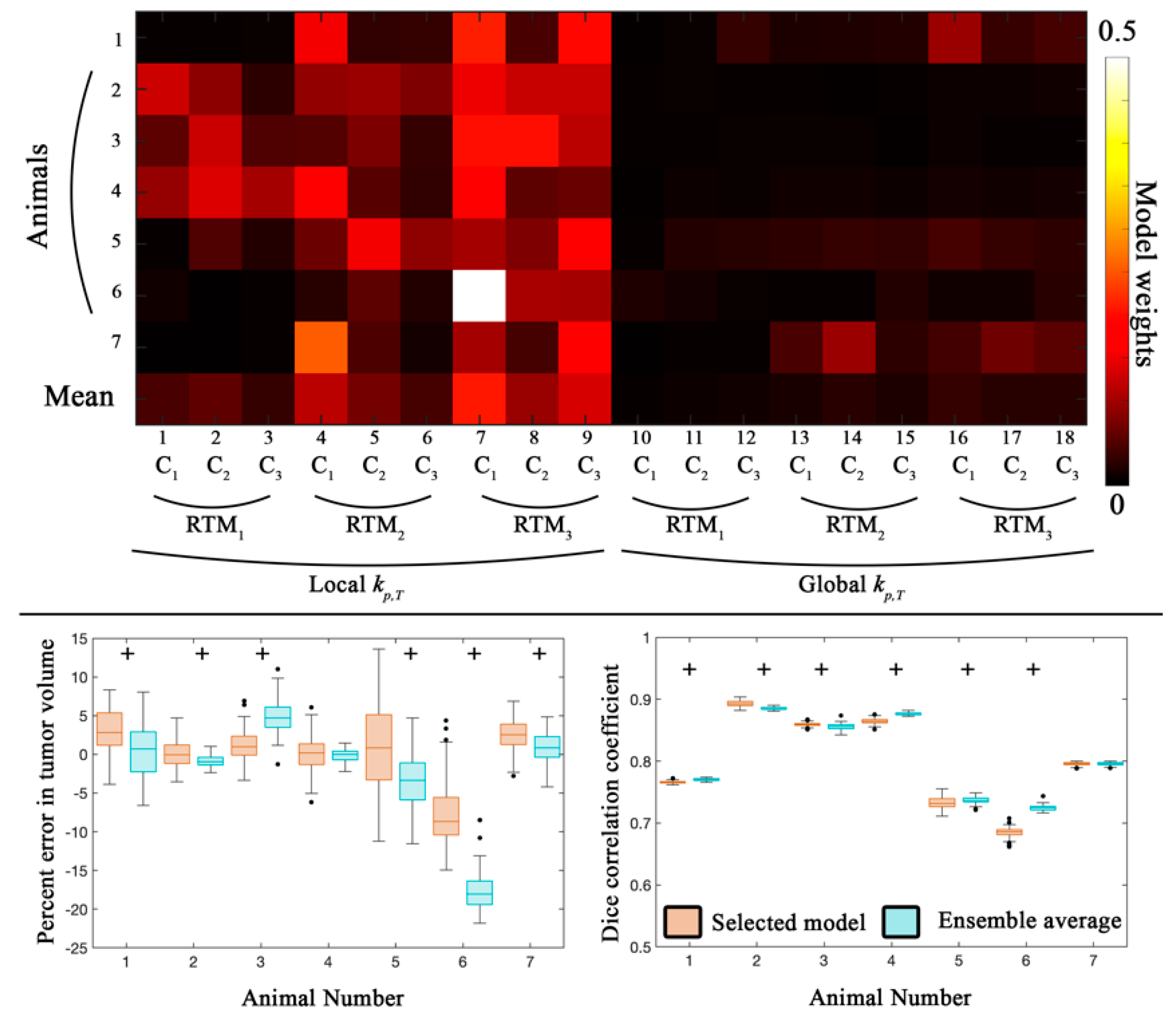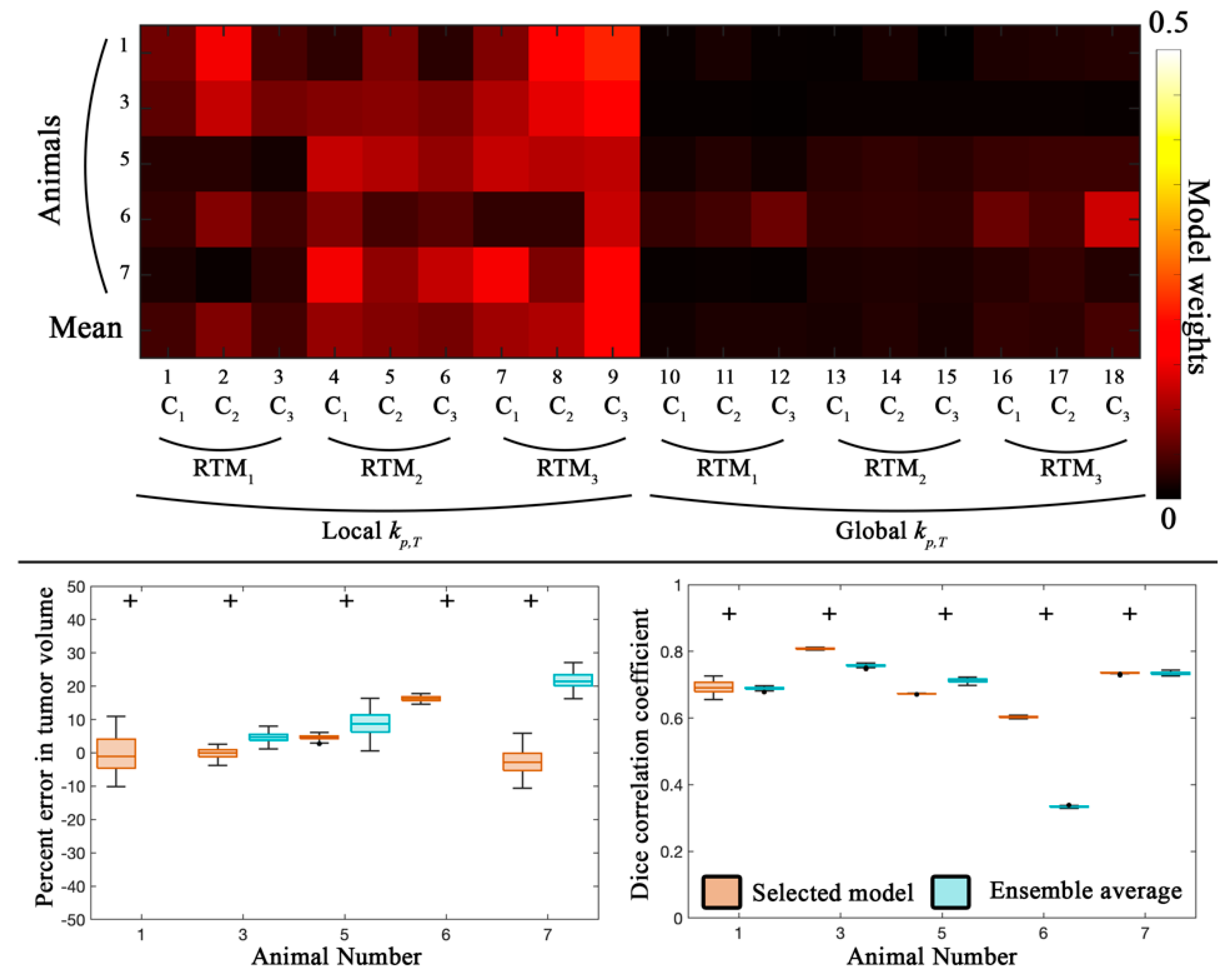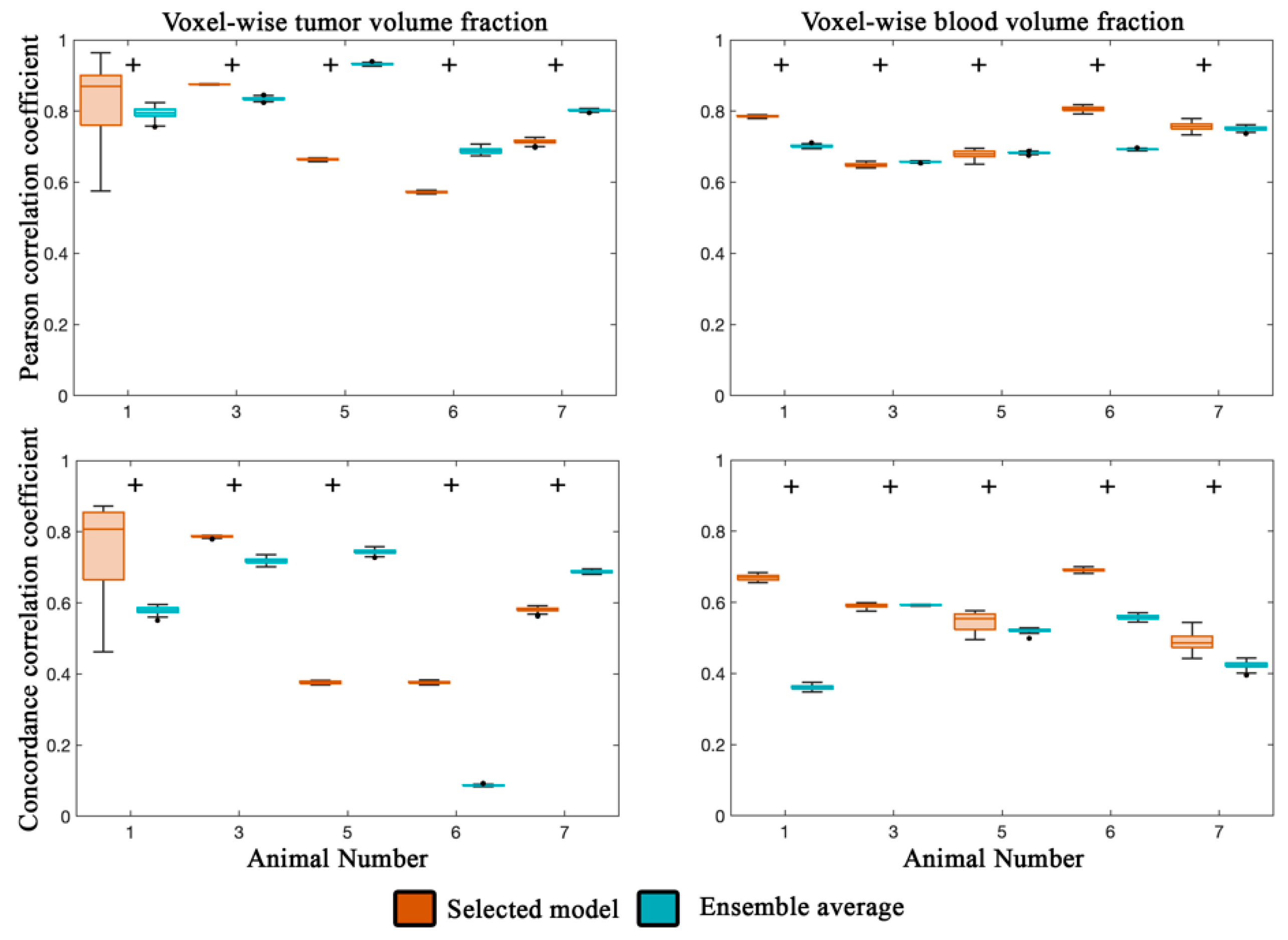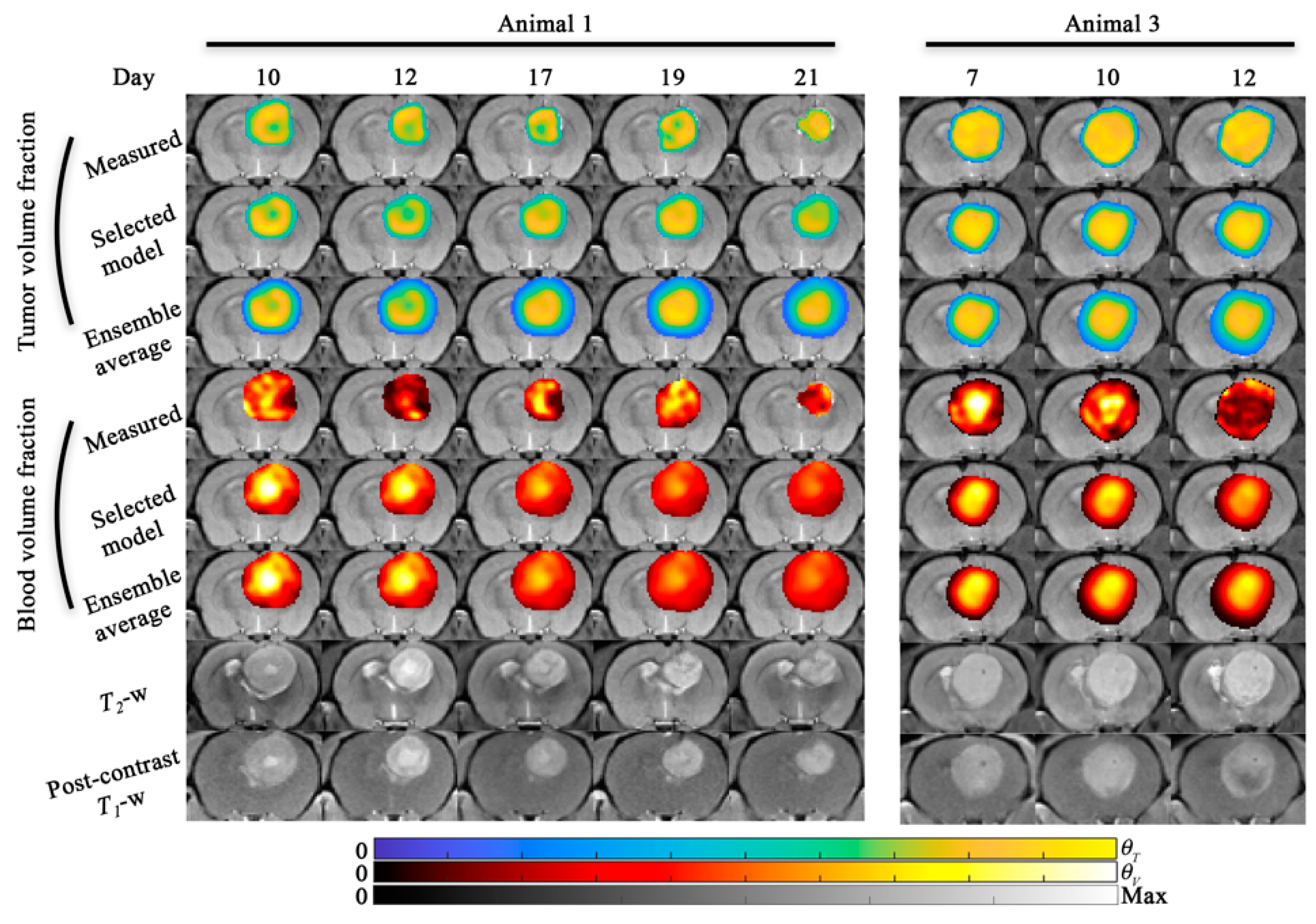Towards an Image-Informed Mathematical Model of In Vivo Response to Fractionated Radiation Therapy
Abstract
:Simple Summary
Abstract
1. Introduction
2. Materials and Methods
2.1. Theory
2.1.1. Mathematical Description of Tumor and Vasculature Growth
2.1.2. Mathematical Descriptions of Response to Fractionated Therapy
2.2. Experimental Methods
2.2.1. Animal Model and Radiation Therapy Protocol
2.2.2. Imaging Procedure
2.3. Numerical and Computational Methods
2.3.1. Finite Difference Approximation
2.3.2. Parameter Calibration (Scenario 1) and Tumor Response Forecasting (Scenario 2)
2.3.3. Model Selection and Ensemble Average
2.4. Error Quantification
3. Results
3.1. Model Calibration Scenario
3.2. Model Prediction Scenario
4. Discussion
5. Conclusions
Supplementary Materials
Author Contributions
Funding
Institutional Review Board Statement
Informed Consent Statement
Data Availability Statement
Acknowledgments
Conflicts of Interest
References
- Omuro, A.; DeAngelis, L.M. Glioblastoma and other malignant gliomas: A clinical review. JAMA 2013, 310, 1842–1850. [Google Scholar] [CrossRef]
- Lagendijk, J.J.W.; Raaymakers, B.W.; Van Vulpen, M. The Magnetic Resonance Imaging–Linac System. Semin. Radiat. Oncol. 2014, 24, 207–209. [Google Scholar] [CrossRef] [PubMed]
- Jaffray, D.A. Image-guided radiotherapy: From current concept to future perspectives. Nat. Rev. Clin. Oncol. 2012, 9, 688–699. [Google Scholar] [CrossRef]
- Jones, K.M.; Michel, K.A.; Bankson, J.A.; Fuller, C.D.; Klopp, A.H.; Venkatesan, A.M. Emerging Magnetic Resonance Imaging Technologies for Radiation Therapy Planning and Response Assessment. Int. J. Radiat. Oncol. Biol. Phys. 2018, 101, 1046–1056. [Google Scholar] [CrossRef] [Green Version]
- Troost, E.G.C.; Thorwarth, D.; Oyen, W.J.G. Imaging-Based Treatment Adaptation in Radiation Oncology. J. Nucl. Med. 2015, 56, 1922–1929. [Google Scholar] [CrossRef] [PubMed] [Green Version]
- Yankeelov, T.E.; Atuegwu, N.; Hormuth, D.A.; Weis, J.A.; Barnes, S.L.; Miga, M.I.; Rericha, E.C.; Quaranta, V. Clinically Relevant Modeling of Tumor Growth and Treatment Response. Sci. Transl. Med. 2013, 5, 187ps9. [Google Scholar] [CrossRef] [PubMed] [Green Version]
- McMahon, S.J. The linear quadratic model: Usage, interpretation and challenges. Phys. Med. Biol. 2019, 64, 01TR01. [Google Scholar] [CrossRef]
- Wouters, B.G. Cell death after irradiation: How, when and why cells die. In Basic Clinical Radiobiology; Joiner, M.C., Van der Kogel, A.J., Eds.; CRC Press: Boca Raton, FL, USA, 2009; pp. 27–40. [Google Scholar]
- Hormuth, D.A.; Jarrett, A.M.; Yankeelov, T.E. Forecasting tumor and vasculature response dynamics to radiation therapy via image based mathematical modeling. Radiat. Oncol. 2020, 15, 4–14. [Google Scholar] [CrossRef] [PubMed]
- Enderling, H.; Chaplain, M.A.J.; Hahnfeldt, P. Quantitative modeling of tumor dynamics and radiotherapy. Acta Biotheor. 2010, 58, 341–353. [Google Scholar] [CrossRef] [PubMed]
- Brüningk, S.; Powathil, G.; Ziegenhein, P.; Ijaz, J.; Rivens, I.; Nill, S.; Chaplain, M.; Oelfke, U.; Ter Haar, G. Combining radiation with hyperthermia: A multiscale model informed by in vitro experiments. J. R. Soc. Interface 2018, 15, 20170681. [Google Scholar] [CrossRef] [Green Version]
- Prokopiou, S.; Moros, E.G.; Poleszczuk, J.; Caudell, J.; Torres-Roca, J.F.; Latifi, K.; Lee, J.K.; Myerson, R.; Harrison, L.B.; Enderling, H. A proliferation saturation index to predict radiation response and personalize radiotherapy fractionation. Radiat. Oncol. 2015, 10, 159. [Google Scholar] [CrossRef] [PubMed] [Green Version]
- Rockne, R.; Rockhill, J.K.; Mrugala, M.; Spence, A.M.; Kalet, I.; Hendrickson, K.; Lai, A.; Cloughesy, T.; Alvord, E.C.; Swanson, K.R. Predicting the efficacy of radiotherapy in individual glioblastoma patients in vivo: A mathematical modeling approach. Phys. Med. Biol. 2010, 55, 3271–3285. [Google Scholar] [CrossRef] [Green Version]
- Elazab, A.; Anter, A.M.; Bai, H.; Hu, Q.; Hussain, Z.; Ni, D.; Wang, T.; Lei, B. An optimized generic cerebral tumor growth modeling framework by coupling biomechanical and diffusive models with treatment effects. Appl. Soft Comput. J. 2019, 80, 617–627. [Google Scholar] [CrossRef]
- Mizutani, T.; Magome, T.; Igaki, H.; Haga, A.; Nawa, K.; Sekiya, N.; Nakagawa, K. Optimization of treatment strategy by using a machine learning model to predict survival time of patients with malignant glioma after radiotherapy. J. Radiat. Res. 2019, 60, 818–824. [Google Scholar] [CrossRef] [PubMed]
- Holdsworth, C.; Corwin, D.; Stewart, R.; Rockne, R.; Trister, A.; Swanson, K.; Philips, M. Adaptive IMRT using a multiobjective evolutionary algorithm integrated with a diffusion–invasion model of glioblastoma. Phys. Med. Biol. 2012, 57, 8271–8283. [Google Scholar] [CrossRef]
- Corwin, D.; Holdsworth, C.; Rockne, R.C.; Trister, A.D.; Mrugala, M.M.; Rockhill, J.K.; Stewart, R.D.; Phillips, M.; Swanson, K.R. Toward Patient-Specific, Biologically Optimized Radiation Therapy Plans for the Treatment of Glioblastoma. PLoS ONE 2013, 8, e079115. [Google Scholar] [CrossRef]
- Kim, M.; Kotas, J.; Rockhill, J.; Phillips, M. A Feasibility Study of Personalized Prescription Schemes for Glioblastoma Patients Using a Proliferation and Invasion Glioma Model. Cancers 2017, 9, 51. [Google Scholar] [CrossRef] [Green Version]
- Budia, I.; Alvarez-Arenas, A.; Woolley, T.E.; Calvo, G.F.; Belmonte-Beitia, J. Radiation protraction schedules for low-grade gliomas: A comparison between different mathematical models. J. R. Soc. Interface 2019, 16. [Google Scholar] [CrossRef] [Green Version]
- Sunassee, E.D.; Tan, D.; Ji, N.; Brady, R.; Moros, E.G.; Caudell, J.J.; Yartsev, S.; Enderling, H. Proliferation saturation index in an adaptive Bayesian approach to predict patient-specific radiotherapy responses. Int. J. Radiat. Biol. 2019, 95, 1421–1426. [Google Scholar] [CrossRef] [Green Version]
- Hormuth, D.A.; Jarrett, A.M.; Feng, X.; Yankeelov, T.E. Calibrating a Predictive Model of Tumor Growth and Angiogenesis with Quantitative MRI. Ann. Biomed. Eng. 2019, 47, 1539–1551. [Google Scholar] [CrossRef]
- Stupp, R.; Mason, W.P.; Van den Bent, M.J.; Weller, M.; Fisher, B.; Taphoorn, M.J.B.; Belanger, K.; Brandes, A.A.; Marosi, C.; Bogdahn, U.; et al. Radiotherapy plus Concomitant and Adjuvant Temozolomide for Glioblastoma. N. Engl. J. Med. 2005, 352, 987–996. [Google Scholar] [CrossRef] [PubMed]
- Padhani, A.R.; Liu, G.; Mu-Koh, D.; Chenevert, T.L.; Thoeny, H.C.; Takahara, T.; Dzik-Jurasz, A.; Ross, B.D.; Van Cauteren, M.; Collins, D.; et al. Diffusion-Weighted Magnetic Resonance Imaging as a Cancer Biomarker: Consensus and Recommendations. Neoplasia 2009, 11, 102–125. [Google Scholar] [CrossRef] [PubMed] [Green Version]
- O’Connor, J.P.B.; Tofts, P.S.; Miles, K.A.; Parkes, L.M.; Thompson, G.; Jackson, A. Dynamic contrast-enhanced imaging techniques: CT and MRI. Br. J. Radiol. 2011, 84, S112–S120. [Google Scholar] [CrossRef] [Green Version]
- Hormuth, D.A., II; Weis, J.A.; Barnes, S.L.; Miga, M.I.; Rericha, E.C.; Quaranta, V.; Yankeelov, T.E. Predicting in vivo glioma growth with the reaction diffusion equation constrained by quantitative magnetic resonance imaging data. Phys. Biol. 2015, 12, 46006. [Google Scholar] [CrossRef] [Green Version]
- Alfonso, J.C.L.; Talkenberger, K.; Seifert, M.; Klink, B.; Hawkins-Daarud, A.; Swanson, K.R.; Hatzikirou, H.; Deutsch, A. The biology and mathematical modelling of glioma invasion: A review. J. R. Soc. Interface 2017, 14, 20170490. [Google Scholar] [CrossRef] [PubMed]
- Rockne, R.; Alvord, E.C.; Rockhill, J.K.; Swanson, K.R. A mathematical model for brain tumor response to radiation therapy. J. Math. Biol. 2009, 58, 561–578. [Google Scholar] [CrossRef] [Green Version]
- Jarrett, A.M.; Hormuth, D.A.; Wu, C.; Syed, A.K.; Virostko, J.; Sorace, A.; DiCarlo, J.C.; Patt, D.; Goodgame, B.; Avery, S.; et al. Evaluating patient-specific neoadjuvant regimens for breast cancer via a mathematical model constrained by quantitative magnetic resonance imaging data. Neoplasia 2020, 22, 820–830. [Google Scholar] [CrossRef]
- Chen, X.; Summers, R.; Jianhua Yao, J. FEM-Based 3-D Tumor Growth Prediction for Kidney Tumor. IEEE Trans. Biomed. Eng. 2011, 58, 463–467. [Google Scholar] [CrossRef]
- Hormuth, D., II; Eldridge, S.B.; Weis, J.; Miga, M.I.; Yankeelov, T.E. Mechanically Coupled Reaction-Diffusion Model to Predict Glioma Growth: Methodological Details. In Springer Methods and Protocols: Cancer Systems Biology; Von Stechow, L., Ed.; Springer: New York, NY, USA, 2018; pp. 225–241. ISBN 978-1-4939-7493-1. [Google Scholar]
- Jove Rodent Stereotaxic Surgery. Available online: https://www.jove.com/t/5205/rodent-stereotaxic-surgery (accessed on 23 March 2021).
- Steinhoff, S.; Zaitsev, M.; Zilles, K.; Shah, N.J. Fast T(1) mapping with volume coverage. Magn. Reson. Med. 2001, 46, 131–140. [Google Scholar] [CrossRef]
- Whisenant, J.G.; Ayers, G.D.; Loveless, M.E.; Barnes, S.L.; Colvin, D.C.; Yankeelov, T.E. Assessing reproducibility of diffusion-weighted magnetic resonance imaging studies in a murine model of HER2+ breast cancer. Magn. Reson. Imaging 2014, 32, 245–249. [Google Scholar] [CrossRef] [Green Version]
- Hormuth, D.A., II; Skinner, J.T.; Does, M.D.; Yankeelov, T.E. A comparison of individual and population-derived vascular input functions for quantitative DCE-MRI in rats. Magn. Reson. Imaging 2014, 32, 397–401. [Google Scholar] [CrossRef] [PubMed] [Green Version]
- Akaike, H. A new look at the statistical model identification. IEEE Trans. Autom. Control 1974, 19, 716–723. [Google Scholar] [CrossRef]
- Yankeelov, T.E.; Quaranta, V.; Evans, K.J.; Rericha, E.C. Toward a Science of Tumor Forecasting for Clinical Oncology. Cancer Res. 2015, 75, 918–923. [Google Scholar] [CrossRef] [Green Version]
- Kallman, R.F.; Dorie, M.J. Tumor oxygenation and reoxygenation during radiation theraphy: Their importance in predicting tumor response. Int. J. Radiat. Oncol. 1986, 12, 681–685. [Google Scholar] [CrossRef]
- Le, M.; Delingette, H.; Kalpathy-Cramer, J.; Gerstner, E.R.; Batchelor, T.; Unkelbach, J.; Ayache, N. Personalized Radiotherapy Planning Based on a Computational Tumor Growth Model. IEEE Trans. Med. Imaging 2016, 36, 815–825. [Google Scholar] [CrossRef]
- López Alfonso, J.C.; Parsai, S.; Joshi, N.; Godley, A.; Shah, C.; Koyfman, S.A.; Caudell, J.J.; Fuller, C.D.; Enderling, H.; Scott, J.G. Temporally feathered intensity-modulated radiation therapy: A planning technique to reduce normal tissue toxicity. Med. Phys. 2018, 45, 3466–3474. [Google Scholar] [CrossRef]
- Rutter, E.M.; Stepien, T.L.; Anderies, B.J.; Plasencia, J.D.; Woolf, E.C.; Scheck, A.C.; Turner, G.H.; Liu, Q.; Frakes, D.; Kodibagkar, V.; et al. Mathematical Analysis of Glioma Growth in a Murine Model. Sci. Rep. 2017, 7, 2508. [Google Scholar] [CrossRef] [PubMed] [Green Version]
- Jiang, X.; Li, H.; Xie, J.; McKinley, E.T.; Zhao, P.; Gore, J.C.; Xu, J. In vivo imaging of cancer cell size and cellularity using temporal diffusion spectroscopy. Magn. Reson. Med. 2017, 78, 156–164. [Google Scholar] [CrossRef]
- Jacobs, V.L.; Valdes, P.A.; Hickey, W.F.; De Leo, J.A. Current review of in vivo GBM rodent models: Emphasis on the CNS-1 tumour model. ASN Neuro 2011, 3, e00063. [Google Scholar] [CrossRef] [Green Version]
- Willey, C.D.; Gilbert, A.N.; Anderson, J.C.; Gillespie, G.Y. Patient-Derived Xenografts as a Model System for Radiation Research. Semin. Radiat. Oncol. 2015, 25, 273–280. [Google Scholar] [CrossRef] [PubMed] [Green Version]
- Schulz, A.; Meyer, F.; Dubrovska, A.; Borgmann, K. Cancer stem cells and radioresistance: DNA repair and beyond. Cancers 2019, 11, 862. [Google Scholar] [CrossRef] [PubMed] [Green Version]
- Johnson, K.; Howard, G.R.; Morgan, D.; Brenner, E.A.; Gardner, A.L.; Durrett, R.E.; Mo, W.; Al’Khafaji, A.; Sontag, E.D.; Jarrett, A.M.; et al. Integrating multimodal data sets into a mathematical framework to describe and predict therapeutic resistance in cancer. Phys. Biol. 2021, 18, 016001. [Google Scholar] [CrossRef] [PubMed]
- Hardee, M.E.; Zagzag, D. Mechanisms of glioma-associated neovascularization. Am. J. Pathol. 2012, 181, 1126–1141. [Google Scholar] [CrossRef] [PubMed] [Green Version]








| Parameter or Variable Group | Parameter or Variable | Interpretation | Source |
|---|---|---|---|
| Measured | Tumor cell volume fraction | DW-MRI | |
| Blood volume fraction | DCE-MRI | ||
| θmin | Minimum value for carrying capacity | DW-MRI | |
| θV | Maximum blood volume | DCE-MRI | |
| DCE-MRI | |||
| Calibrated | kp,T,0 | Tumor cell proliferation rate | Calibrated globally or locally |
| kd,T,0 | Tumor cell death rate | Calibrated globally | |
| DT,0, DV,0 | ϕT and ϕV diffusion coefficients in the absence of mechanically coupling | Calibrated globally | |
| ϕV,thresh | Threshold on ϕV for carrying capacity to decrease | Calibrated globally | |
| θmax | Max carrying capacity | Calibrated globally | |
| kp,V | Vasculature proliferation rate | Calibrated globally | |
| kd,V | Vasculature death rate | Calibrated globally | |
| SF | Surviving fraction | Calibrated globally | |
| α1 | Coupling constant | Calibrated globally | |
| Assigned | d | Distance to the periphery of the tumor | Calculated |
| Combined ϕT and ϕV carrying capacity | Calculated | ||
| λ1 | Coupling Constant | Set to 0.25 | |
| λ2 | Coupling Constant | Set to 1 | |
| G, ν | Shear modulus and Poisson’s ratio assigned for white and gray matter | Literature [30] |
| Animal Number | Dose/Day | Image Days | Treatment Dates | Calibration Dates | Prediction Dates |
|---|---|---|---|---|---|
| 81 | 2 Gy | 0,3,5,7,10, 12,17,19,21 | 3–7,10–14 | 0–7 | 10–21 |
| 2 | 4 Gy | 0,3,5 | 3–5 | 0–5 | NA |
| 3 | 2 Gy | 0,3,5,7,10,12 | 3–7,10–12 | 0–5 | 7–12 |
| 4 | 2 Gy | 0,3,5 | 3–6 | 0–5 | NA |
| 5 | 2 Gy | 0,3,5,7 | 3–6 | 0–5 | 7 |
| 6 | 4 Gy | 0,2,5,7,8, 12,14,16,19 | 0–2,6–9,12,13 | 0–7 | 8–19 |
| 7 | 4 Gy | 0,3,5,7,10, 12,14,17 | 3–7,10–14 | 0–7 | 10–17 |
| Parameter or Variable | Animal Number (Dose per Day) | ||||||
|---|---|---|---|---|---|---|---|
| 1 (2 Gy) | 2 (4 Gy) | 3 (2 Gy) | 4 (2 Gy) | 5 (2 Gy) | 6 (4 Gy) | 7 (4 Gy) | |
| kp,T,0 (day−1) | 0.84 ± 0.25 | 1.20 ± 0.35 | 1.40 ± 0.48 | 1.10 ± 0.16 | 1.82 ± 0.21 | 4.65 ± 5.45 | 2.04 ± 0.43 |
| kd,T,0 (day−1) | 0.22 ± 0.04 | 0.40 ± 0.07 | 0.11± 0.01 | 0.03 ± 0.06 | 0.5 ± 0.10 | 0.35 ± 0.04 | NA |
| DT,0 (104 m2 day−1) | 2.32 ± 0.07 | 4.50 ± 0.07 | 2.58 ± 0.07 | 1.37 ± 0.02 | 3.44 ± 0.05 | 6.93 ± 0.30 | 3.38 ± 0.02 |
| DV,0 (104 m2 day−1) | 2.72 ± 0.06 | 3.00 ± 0.09 | 3.10 ± 0.09 | 3.00 ± 0.19 | 3.11 ± 0.05 | 3.25 ± 0.12 | 3.00 ± 0.04 |
| ϕV,thresh | 0.03 ± 0.12 | 0.05 ± 0.06 | 0.03 ± 0.05 | 0.03 ± 0.02 | 0.02 ± 0.04 | 0.02 ± 0.02 | 0.02 ± 0.08 |
| θmax | 0.90 ± 0.01 | 0.90 ± 0.02 | 0.94 ± 0.02 | 0.87 ± 0.03 | 0.92 ± 0.01 | 0.91 ± 0.00 | 0.92 ± 0.01 |
| kp,V (day−1) | 0.65 ± 0.03 | 1.10 ± 0.06 | 0.82 ± 0.04 | 1.25 ± 0.17 | 1.49 ± 0.13 | 0.17 ± 0.47 | 1.76 ± 0.02 |
| kd,V (day−1) | 0.18 ± 0.02 | 0.32 ± 0.06 | 0.29 ± 0.04 | 0.54 ± 0.10 | 0.97 ± 0.17 | 0.07 ± 0.04 | 0.07 ± 0.04 |
| SF | 0.95 ± 0.01 | 0.80 ± 0.08 | 0.97 ± 0.01 | 0.99 ± 0.01 | 0.98 ± 0.02 | 0.90 ± 0.01 | 0.91 ± 0.01 |
| α1 | NA | NA | 4.00 ± 0.17 | NA | NA | NA | NA |
Publisher’s Note: MDPI stays neutral with regard to jurisdictional claims in published maps and institutional affiliations. |
© 2021 by the authors. Licensee MDPI, Basel, Switzerland. This article is an open access article distributed under the terms and conditions of the Creative Commons Attribution (CC BY) license (https://creativecommons.org/licenses/by/4.0/).
Share and Cite
Hormuth, D.A., II; Jarrett, A.M.; Davis, T.; Yankeelov, T.E. Towards an Image-Informed Mathematical Model of In Vivo Response to Fractionated Radiation Therapy. Cancers 2021, 13, 1765. https://doi.org/10.3390/cancers13081765
Hormuth DA II, Jarrett AM, Davis T, Yankeelov TE. Towards an Image-Informed Mathematical Model of In Vivo Response to Fractionated Radiation Therapy. Cancers. 2021; 13(8):1765. https://doi.org/10.3390/cancers13081765
Chicago/Turabian StyleHormuth, David A., II, Angela M. Jarrett, Tessa Davis, and Thomas E. Yankeelov. 2021. "Towards an Image-Informed Mathematical Model of In Vivo Response to Fractionated Radiation Therapy" Cancers 13, no. 8: 1765. https://doi.org/10.3390/cancers13081765






